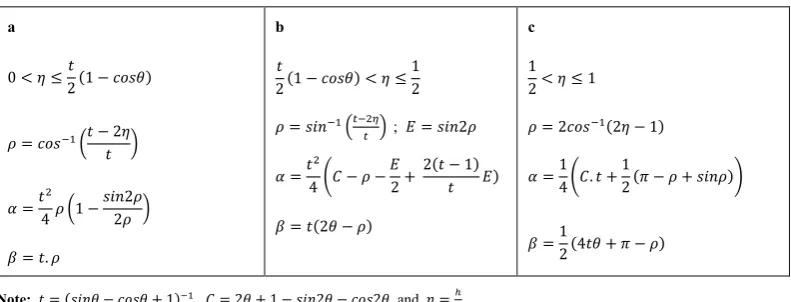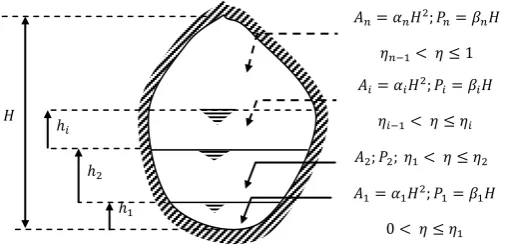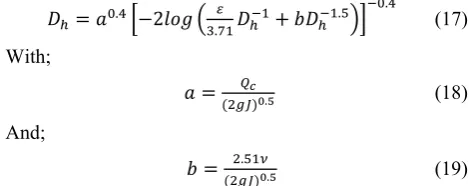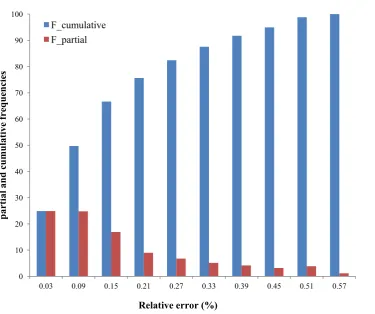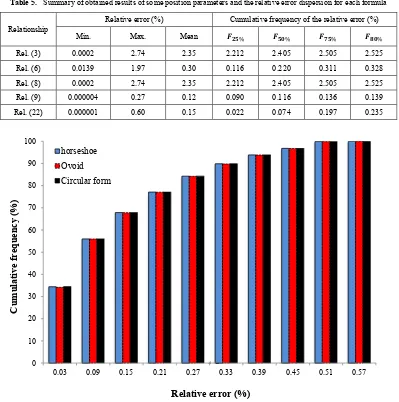High Accurate Explicit Solution for the
Determination of Conduit Height
Nasreddine Meziane1,*, Ahmed Bettahar2, M’hamed Beriache2
1Hydraulic Department, Faculty of Civil Engineering and Architecture, University Hassiba Benbouali of Chlef, Chlef, Algeria 2Mechanical Engineering Department, Faculty of Technology, University Hassiba Benbouali of Chlef, Chlef, Algeria
Abstract
The objective of this work is to propose a new approach to dimensioning of the conduits partially or totally filled. To dimension the conduit, the wetted section and the wetted perimeter have to be expressed under the forms 𝐴=𝛼𝐻2and 𝑃=𝛽𝐻. The study is based on the relationships universally known of the Darcy-Weisbach and of Colebrook-White. In this study, the new developed approach leads to an explicit solution and the ensuing results can be compared to the different exiting models. The maximum relative error obtained of the 80% calculated values does not exceed 0.25%. What enables us to say that this approach adapts well to manual and computing calculations. It was found that this new contribution is more accurate than the most equations available literature.
Keywords
Dimensioning, Conduit partially filled, Conduit totally filled, Explicit relationship, Conduit diameter1. Introduction
Flow in a conduit partially or totally filled is governed by a functional relationship of type 𝜑(𝑄,𝐽,𝐷ℎ,𝜀,𝜂) = 0, where
Q is the volume flow rate, J is the hydraulic slope in a section of the conduit or of the channel of length 𝑙, 𝐷ℎ is the
hydraulic diameter, 𝜀 is the absolute roughness of the conduit wall and 𝜂 is the filling rate. The dynamic viscosity 𝜇 and density of the fluid 𝜌 being known, so as the length 𝑙 of the conduit and its absolute roughness 𝜀 (depending on the used material). Three types of problems occur: I-Determine the hydraulic slope J of the conduit knowing its diameter and an imposed volume flow. II-Determine the volume flow 𝑄 in the conduit knowing its diameter and a hydraulic slope imposed. III-Determine the hydraulic diameter 𝐷ℎ or geometric diameter of conduit D knowing
the volume flow at ensure under an imposed hydraulic slope. In turbulent flow, the hydraulic slope is more or less exactly proportional to the square of the velocity (respectively volume flow rate). Also, the shear stress at the wall 𝜏𝑝 (for a
noncircular cross section its mean value) is equal to
0.5𝜆𝜌𝑣2, where 𝜆 is a number depending on the particular
conditions and mainly of the wall roughness, and 𝑣 is the mean velocity. The hydraulic slope in a section of conduit or of the channel of length 𝑙 must ensure the equilibrium of the tangential tensions at the wall surface. Therefore, v, J and 𝐷ℎ
are related by the well-famous equation of Darcy [6] Rel. (1), that, applied to a conduit partially or totally filled, is written
* Corresponding author:
meznasr@gmail.com (Nasreddine Meziane) Published online at http://journal.sapub.org/ijhe
Copyright © 2015 Scientific & Academic Publishing. All Rights Reserved
in the form:
𝐽=𝐷𝜆
ℎ
𝑣2
2𝑔 (1)
According to the classification of the problems in the field of practical calculation of the conduits cited above, the problem of type III is the most frequently encountered in engineering problems (full circular pipe), and also the most difficult to solve. The general law of the linear load loss coefficient of Colebrook [5] Rel. (2) has an algebraic form which often leading to numerical calculations by iteration. Therefore, we use more frequently the graphic methods based on the use of the Moody diagram (Moody 1947).
1
√𝜆=−2𝑙𝑜𝑔 � 𝜀 3.71𝐷ℎ+
2.51
ℛ𝑒√𝜆� (2)
study can be adapted to any form of conduits or channels in charge or open channel flow.
2. Geometric Properties
Considering the Fig.1 for a flow section of given geometric form:
Either:
𝐴𝑖, 𝑃𝑖, 𝜂𝑖 and 𝐻 are respectively, the wetted section, the
wetted perimeter, the maximum filling ratio of the zone of rank i and the height of the conduit.
Also:
𝛼𝑖, 𝛽𝑖 and ℎ𝑖 are respectively, the relative coefficient of
the wetted section, the relative coefficient of the wetted perimeter and the maximum water height of the zone of rank
i. The formulas presented below are to perform the calculation of geometric elements at one and three depth zones of some usual cross-sections: Table 1 oval section, Table 2 horseshoe section and Table 3 circular section.
Ovoid section
Table 1 presents the formulas of geometric elements of an ovoid section composed of three zones of heights.
Horseshoe cross section
Table 2 presents the formulas of geometric elements of a horseshoe form section composed of three zones of heights.
Circular section
The calculation formulas of geometric elements of a circular section can be deduced from formulas of a horseshoe section by replacing 𝑡= 1 (cf. Table 3).
Table 1. The calculation formulas of geometric elements of three depth zones of an ovoid section
a
0 <𝜂 ≤151 or 0 <ℎ ≤15𝐻
𝜃= 1−6𝜂
𝛼=𝑐𝑜𝑠−1𝜃 − 𝜃√36 1− 𝜃2
𝛽=𝑐𝑜𝑠3−1𝜃
b 1 15<𝜂 ≤
2 3 or
𝐻 15<ℎ ≤
2𝐻 3
𝜃=23− 𝜂
𝛼= 0.3359−2𝑠𝑖𝑛−1𝜃 − 𝜃 ��1− 𝜃2−4
3�
𝛽= 1.5961−2𝑠𝑖𝑛−1𝜃
c 2
3<𝜂 ≤1 or 2𝐻
3 <ℎ ≤ 𝐻
𝜃=𝜂 −23
𝛼= 0.5105−19𝑐𝑜𝑠−13𝜃+ 𝜃�1
9− 𝜃2
𝛽= 2.6433−23𝑐𝑜𝑠−13𝜃
Table 2. The calculation formulas of geometric elements of three depth zones of a horseshoe form section
a
0 <𝜂 ≤2𝑡(1− 𝑐𝑜𝑠𝜃)
𝜌=𝑐𝑜𝑠−1�𝑡 −2𝜂 𝑡 �
𝛼=𝑡42𝜌 �1−𝑠𝑖𝑛2𝜌2𝜌�
𝛽=𝑡.𝜌
b
𝑡
2(1− 𝑐𝑜𝑠𝜃) <𝜂 ≤ 1 2
𝜌=𝑠𝑖𝑛−1�𝑡−2𝜂
𝑡 �; 𝐸=𝑠𝑖𝑛2𝜌 𝛼=𝑡42�𝐶 − 𝜌 −𝐸2+ 2(𝑡 −𝑡 1)𝐸)
𝛽=𝑡(2𝜃 − 𝜌)
c
1 2<𝜂 ≤1
𝜌= 2𝑐𝑜𝑠−1(2𝜂 −1)
𝛼=14�𝐶.𝑡+12(𝜋 − 𝜌+𝑠𝑖𝑛𝜌)�
𝛽=1
2(4𝑡𝜃+𝜋 − 𝜌)
Note: 𝑡= (𝑠𝑖𝑛𝜃 − 𝑐𝑜𝑠𝜃+ 1)−1, 𝐶= 2𝜃+ 1− 𝑠𝑖𝑛2𝜃 − 𝑐𝑜𝑠2𝜃 and 𝜂=ℎ 𝐻
Table 3. The calculation formulas of geometric elements of one depth zone of a circular section
0 <𝜂 ≤1 𝑜𝑢 0 <ℎ ≤ 𝐻
𝜃=𝑐𝑜𝑠−1(1−2𝜂)
𝛼=𝜃4�1−𝑠𝑖𝑛2𝜃2𝜃�
3. Diameter Calculation (Governing Equations)
Circular section filledSwamee and Jain [17] have obtained an approximate explicit solution of the pipe diameter with a relative error of ± 2%, Rel. (3). The latter is valid for the following initial conditions: 3 × 103≤ ℛ
𝑒≤3 × 108, 2 × 10−6≤ 𝜀/𝐷 ≤2 × 10−2𝑒𝑡
10−6≤ 𝜀
∗≤10−2 and 10−8≤ 𝜈∗≤10−3
𝐷= 0.66𝜀𝜀
∗[𝜀∗
1.25+𝜈
∗]0.04 (3)
With;
𝜀∗=𝜀 �𝑄𝑔𝐽2�
0.2
(4) And,
𝜈∗=𝜈(𝑔𝐽𝑄3)−0.2 (5)
Where:𝑄, 𝐽, 𝜀, 𝜈 and 𝑔 are respectively the flow rate, the hydraulic slope, the absolute roughness, the kinematic viscosity of the fluid and the gravitational acceleration.
Thereafter, Swamee and Rathie [20] have obtained an analytical solution of the diameter, it is in form of a convergent series based on the implicit equation of Lagrange. According to these authors, the use of the expression Rel. (6) with three terms ensures sufficient accuracy and respectively two terms is sufficiently precise for all practical purposes.
�𝐷𝜀∗
𝜀� −52
=𝑑+ 0.9647𝐿𝑛 �0.1518𝜀∗
𝜈∗ 𝑑 2
5+𝑑35�×�−1 +
0.5788�0.1012𝜀∗+𝜈∗𝑑 1 5� �0.1518𝜀∗+𝜈∗𝑑
1
5�𝑑 � (6)
With;
𝜀∗, 𝜈∗ (relations Rel. (4) and (5)) and d given by the following relationship
𝑑= 0.9647𝐿𝑛 �(1.78𝜈1
∗)� (7)
Furthermore, Swamee and Swamee [21] have presented the following equation Rel. (8) for the calculation of the diameter with a relative error oscillating between -2.75 and 2.75%. The error interval is valid for: 0 <ℛ𝑒≤3 × 108, 2 × 10−6≤
𝜀/𝐷 ≤2 × 10−2, 10−6≤ 𝜀
∗≤10−2 and 10−8≤ 𝜈∗≤ ∞
𝐷= 0.66��214.75𝜈𝑄𝑔𝐽�6.25+𝜀1.25�𝑄2 𝑔𝐽�
4.75
+𝜈𝑄9.4�1 𝑔𝐽�
5.20
�0.04 (8) Also, Babajimopoulos and Terzidis (2013) have presented an explicit method Rel. (9) for the diameter calculation. The obtained mean relative error is of the order of 0.36%, which is valid for: 104≤ ℛ
𝑒≤108, 10−5≤ 𝜀/𝐷 ≤5 × 10−2,
4 × 10−6≤ 𝜀
∗≤3 × 10−2 and 2.5 × 10−8≤ 𝜈∗≤2.5 × 10−4.
𝐷= 0.95887[−1.886𝑙𝑜𝑔(0.3829𝜀∗1.006+ 3.762𝜈∗1.001)]−0.4 𝜀𝜀∗ (9)
With; 𝜀∗, 𝜈∗ (relations Rel. (4) and (5))
𝐴1=𝛼1𝐻2;𝑃 1=𝛽1𝐻
0 < 𝜂 ≤ 𝜂1 𝐻
Figure 1. Flow section composed of n zones
ℎ1 ℎ2 ℎ𝑖
𝐴2;𝑃2; 𝜂1< 𝜂 ≤ 𝜂2 𝐴𝑖=𝛼𝑖𝐻2;𝑃𝑖=𝛽𝑖𝐻
𝜂𝑖−1< 𝜂 ≤ 𝜂𝑖 𝐴𝑛=𝛼𝑛𝐻2;𝑃
𝑛=𝛽𝑛𝐻
4. Basic Equations
By replacing the mean velocity 𝑣 in the Rel. (1) by the expression 𝑄 𝐴⁄ , hydraulic slope (unit head loss charge) is written as follows.
𝐽=𝐷𝜆
ℎ
𝑄2
2𝑔𝐴2 (10)
Either 𝐴 and 𝑃 the geometric elements with a single depth zone Fig. (1). The hydraulic diameter 𝐷ℎ is expressed
as a function of these two parameters by the relationship below.
𝐷ℎ=4𝛼𝛽 𝐻 (11)
By posing the expression 𝐴=𝛼𝐻2 in the relationship
(11), we get:
𝐴=𝐷ℎ2
𝑐 (12)
With;
𝑐= 𝛼
�𝛽 4� �2 (13)
By replacing Rel. (12) in (10), the hydraulic slope becomes: By replacing Rel. (12) in (10), the hydraulic slope becomes:
𝐽=2𝑔𝜆 𝑄𝑐2
𝐷ℎ5 (14)
With;
𝑄𝑐=𝑐𝑄 (15)
ℛ𝑒 is the Reynolds number which can be expressed as
follows:
ℛ𝑒=𝜈𝐷𝑄𝑐ℎ (16)
Subsequently, the elimination of 𝜆 and ℛ𝑒√𝜆 in the Rel.
(2) is done by using the relationships (14) and (16). As a result, 𝐷ℎ can be expressed by the following relationship.
𝐷ℎ=𝑎0.4�−2𝑙𝑜𝑔 �3.𝜀71𝐷ℎ−1+𝑏𝐷ℎ−1.5�� −0.4
(17) With;
𝑎= 𝑄𝑐
(2𝑔𝐽)0.5 (18)
And;
𝑏=(2𝑔𝐽2.51𝜈)0.5 (19)
Admitting that values of ε, a and b are given, relation (17) shows that the value of the hydraulic diameter Dh cannot be
explicitly determined. Indeed, the relation (17) is implicit vis-a-vis of Dh, because this one is contained in both the left
and right members of the relationship. The Determining of the diameter Dh therefore requires an iterative method in the
case where the relation (17) is used.
Proposed Relationship
A number of 226980 exact values of 𝐷ℎ was generated by
the numerical solution of the Rel. (17) with the conditions:
3 × 103≤ ℛ
𝑒≤107, 10−6≤ 𝜀/𝐷 ≤2 × 10−1, 10−5≤
𝐽 ≤10−2 and 0.5 × 10−3≤ 𝑄
𝑐≤10. All the necessary
coefficients for the prediction of the hydraulic diameter were obtained. Firstly, by the optimization method of nonlinear equations using approximation technique, and secondly, by minimizing the maximum relative error. The relationship (20) given below predicts the hydraulic diameter 𝐷ℎ𝑝 with the
desired accuracy.
𝐷ℎ𝑝= 0.8𝜀0.95+ 0.514𝑎0.383 (20)
By introducing the relationship (20) in the second term of relationship (17), we obtain a relationship Rel. (21) expressing the estimation of hydraulic diameter Dhe.
𝐷ℎ𝑒=𝑎0.4�−2𝑙𝑜𝑔 �3.𝜀71𝐷ℎ𝑝−1+ 0.67𝑏0.95𝐷ℎ𝑝−1.5�� −0.4
(21) In order to better specify the reliability of the explicit relation (21), we have compared at that mentioned by the implied relationship (17), taken as the reference. Assuming that, for each value ε, a and b implicitly Q, J and ε are fixed and chosen in the range of application conditions, equation (17) gives, after an iterative method, an exact value and that proposed by equation (21) affects an approximate value of the hydraulic diameter.
The relative error
Statistical analysis of the 226980 values estimated by the Rel. (21) and those obtained numerically by Rel. (17) shows that: a maximum relative error of the order of 0.6% and a minimum relative error of the order of 7.5 × 10−9%. On the
basis of these two extreme errors, a calculation of the partial and cumulative frequencies is performed from the relative error orderly into ten (10) centered class. Figure 2 shows that 50% of the values obtained by Rel. (21) have lower relative errors than 0.09% and more of 80% of values have relative errors lower than 0.25%. Note that, the probability of obtaining a relative error greater than 0.45% is 3%. Furthermore, an average error of 0.17% is recorded.
Figure 3 shows a perfect linear relationship between the exact hydraulic diameter calculated by the Rel. (17) and that estimated by the Rel. (21). The linear equation Fig. (3) has a coefficient of determination 𝑅2 that equals 0.99998 where
this value judge a good linear regression between the two hydraulic diameters.
Dimensioning of a conduit
Note that for a flow section of shape described by Fig. (1), the dimension 𝐻 can be calculated by applying the following explicit relationship, issued from the combination of relations (11) and (21).
𝐻=4𝛼𝛽 𝑎0.4�−2𝑙𝑜𝑔 � 𝜀
3.71𝐷ℎ𝑝−1+ 0.67𝑏0.95𝐷ℎ𝑝−1.5�� −0.4
(22) For the given values of the parameters 𝜀,𝜈,𝑄,𝐽,𝛼 and 𝛽 the steps of calculating of the total height H of the conduit are then as follows: The relationships (18) and (19) allow to determine the coefficients 𝑎 and 𝑏 by replacing 𝑄𝑐 by
(𝑐𝑄) where 𝑐 is given by relationship (13). Then, 𝜀 and 𝑎 are introduced in the relationship (20) for predicting the hydraulic diameter 𝐷ℎ𝑝 which is than introduced in
Figure 2. Distribution of partial and of cumulative frequencies of the relative error (%)
Figure 3. Values of (Dhe) calculated by equation (21) compared to the exact values (Dh) calculated by equation (17)
0 10 20 30 40 50 60 70 80 90 100
0.03 0.09 0.15 0.21 0.27 0.33 0.39 0.45 0.51 0.57
pa
rt
ia
l a
nd
cu
mu
la
tiv
e f
req
uen
ci
es
Relative error (%)
Table 4. Summary of the obtained results and the conditions of application of each formula
Relationship ℛ𝑒 𝜀/𝐷 𝜈∗ 𝜀∗ N
Min. Max. Min. Max. Min. Max. Min. Max.
Rel. (3) 3.90x103 3.49x107 2.68x10-6 1.89x10-2 10-7 6.06x10-4 10-6 9.94x10-3 222356
Rel. (6) 3.62x103 3.53x107 6.80x10-7 1.99x10-1 10-7 6.06x10-4 2.5x10-5 1.31x10-1 226980
Rel. (8) 3.90x103 3.49x107 2.68x10-6 1.89x10-2 10-7 6.06x10-4 10-6 9.94x10-3 222356
Rel. (9) 10x103 3.29x107 1.04x10-5 5.00x10-2 10-7 2.50x10-4 4.03x10-6 2.84x10-2 220482
Rel. (22) 3.62x103 3.53x107 6.80x10-7 1.99x10-1 226980
Note: N is the number of sorted values corresponding to the conditions of application of each formula.
Table 5. Summary of obtained results of some position parameters and the relative error dispersion for each formula Relationship Relative error (%) Cumulative frequency of the relative error (%)
Min. Max. Mean 𝑭𝟐𝟓% 𝑭𝟓𝟎% 𝑭𝟕𝟓% 𝑭𝟖𝟎%
Rel. (3) 0.0002 2.74 2.35 2.212 2.405 2.505 2.525 Rel. (6) 0.0139 1.97 0.30 0.116 0.220 0.311 0.328 Rel. (8) 0.0002 2.74 2.35 2.212 2.405 2.505 2.525 Rel. (9) 0.000004 0.27 0.12 0.090 0.116 0.136 0.139 Rel. (22) 0.000001 0.60 0.15 0.022 0.074 0.197 0.235
Figure 4. Distribution of cumulative frequencies of the relative error for three cross sections of usual forms
Case of a circular conduit under pressure
A number of 226980 exact values of the conduit diameter of circular form under pressure was calculated by solving numerically the rel. (17) by replacing 𝑄𝑐 by (𝑐𝑄) with
𝑐=𝜋4. Application conditions obtained are: 3.62 × 103≤
ℛ𝑒≤3.53 × 107, 6.80 × 10−7≤ 𝜀/𝐷 ≤1.99 × 10−1 ,
10−5≤ 𝐽 ≤10−2 et 0.5 × 10−3≤ 𝑄 ≤100. Then, the
estimated values of the diameter are calculated on basis of
application conditions of each formula. The obtained results, the applications for each formula and some position parameters and their relative error dispersion are respectively summarized in the tables 4 and 5.
A priori, Table 5 shows that the relationship (3) of Swamee and Jain [17] and the relation (8) of Swamee and Swamee [21] differ only in the writing of their expressions and their application conditions. In addition, the two expressions Rel. (3) and (8) gives important relative errors
0 10 20 30 40 50 60 70 80 90 100
0.03 0.09 0.15 0.21 0.27 0.33 0.39 0.45 0.51 0.57
C
umu
la
tiv
e
freq
uen
cy
(%
)
Relative error (%)
compared to available other formulas. The relationship (6) of Swamee and Rathie [20] is approximately eight times more precise than the two preceding. Certainly, the relationship (9) of Babajimopoulos and Terzidis [2] offers better accuracy on the maximum value, the mean and the cumulative frequency to 80%. Also, the relationship (22) "case of a circular pipe" gives a good accuracy on the minimum value and the cumulative frequency to 50%. The mean relative error obtained by the present proposed relationship is reduced of 50% comparatively than that calculated by the Rel. (6) but it is increased of 25% comparatively than that obtained by the Rel. (9).
Case of a noncircular section under pressure
The conditions of the numerical experimentation are identical to those applied for a circular section. The only difference lies on the taken values of α and β. The calculation was performed, on the one hand, α = 0.5105 and β = 2.6433 for an oval section, and on the other hand, α = 0.8293 and β = 3.2669 for a section in the shape of a horseshoe. Figure 4 shows that the cumulative frequency distribution of the relative errors are almost identical between the two sections (ovoid form and horseshoe form) and the circular section. In front of this result, the dimensioning of such sections is performed at 80% of chance with a maximum relative error of the order of 0.25% and at 95% with a maximum relative error of the order of 0.40%.
5. Conclusions
The relationship proposed in this paper has been applied successfully to calculate the total height that serves to dimensioning a conduit. The total height H of a conduit is an important element in the conception, the exploitation and maintenance of pipes and channels. The calculation of this element is performed either by numerical methods, graphics, and analytical approaches or by the aid of explicit regressive equations. The explicit solutions are available in the literature for the calculation of the friction coefficient λ, and consequently, for the calculation the diameter D of the pipes under pressure. The maximum relative error of the proposed relationship is less than 0.25% for 80% of calculated values and a mean relative error of 0.17%. In the case of completely filled circular conduit, the relationship is well classified among the various explicit equations mentioned in this document where it has both simplicity and accuracy. The new approach proposed in the present study offers the possibility to solve problems linked to dimensioning of pipes and channels with high accuracy comparatively to those available in the literature. Consequently, it can be used successfully for practical purposes.
List of Symbols
Q = water discharge [m3s-1]
Qc = flow calculation [m3s-1]
J = hydraulic gradient [m]
Dh = hydraulic diameter [m]
Dhp = hydraulic diameter predicts [m]
Dhe = hydraulic diameter estimated [m]
D = geometric diameter [m]
l = length of the conduit or of the channel [m]
v = mean velocity[ms-1]
g = Gravitational acceleration [ms-2]
Re = Reynolds number [adimensional]
Ai = wetted section of rank i [m]
Pi = wetted perimeter of rank i [m]
hi = maximum water height of the zone of rank i [m]
H = height of the conduit [m]
Symbols
ηi = maximum filling ratio of the zone of rank i
[adimensional]
ε = absolute roughness [m]
η = Dimensionless [m]
µ = dynamic viscosity [Nm-2s-1]
ρ = density of fluid [kgm-3]
θ = cross-section angle [radians]
α = coefficient of the wetted section [adimensional]
β = coefficient of the wetted perimeter [adimensional]
τp = shear stress [Nm-2]
λ = friction factor [adimensional]
ϕ = function [adimensional]
Subscripts * = [adimensional] Max= maximum value Min = minimum value c = calculation
REFERENCES
[1] Achour B., Bedjaoui A., Khattaoui M. and Dababeche M. (2002). “Contribution au calcul des écoulements uniformes à surface libre et en charge”. Larhyss/Journal n°1, 7-36. [2] Babajimopoulos C. and Terzidis G. (2013).”Accurate Explicit
Equations for the Determination of Pipe Diameters". J.
Hydraul. Eng., Vol. 2, No. 5, pp. 115-120.
[3] Bedjaoui A., and Achour B. (2010). “Nouvelle approche pour le dimensionnement des conduites circulaires sous pression”.
Courrier du Savoir – N°10, pp.23-29.
[4] Bombardelli F., and Garcia M. (2003). "Hydraulic Design of Large-Diameter Pipes”. J. Hydraul. Eng., 129(11), 839-846. [5] Brkić D. (2011a). “New explicit correlations for turbulent
flow friction factor”. Nucl. Eng. Des., 241(9), 4055-4059. [6] Colebrook C. F. (1939). “Turbulent flow in Pipes, with
particular reference to the transition region between the smooth and rough pipe laws”. J. Inst. Civil Eng., 11(4), 133-156.
des séances de l’Académie des Sciences, Vol.38, 1109-1121. [8] Diniz V. E. M. G., and Souza P. A. (2009). “Four explicit
formulae for friction factor calculation in pipe flow”.
Transactions on Ecology and the Environment, 125 369-380.
[9] Giustolisi O., Berardi L., and Walski T. M. (2011). “Some explicit formulations of Colebrook–White friction factor considering accuracy vs. computational speed”. Journal of
Hydroinformatics, 13(3), 401-418.
[10] Gulyani B. B. (2001). “Approximating equations for pipe sizing”. Chemical Engineering, 108(2), 105-108.
[11] Haaland S. E. (1983). “Simple and Explicit Formulas for the Friction Factor in Turbulent Pipe Flow”. J. Fluids Eng.,
105(1), 89-90.
[12] Hager W.H. (1987). “Computation of turbulent conduit flows”. 3R-International, Vol.26, 116-121.
[13] Imbrahim C. (2005). “Simplified equations calculates head losses in commercial pipes.” The Journal of American
Science, 1(1), 1-2.
[14] Jain K. (1976). “Accurate explicit equation for friction factor.”
Journal of Hydraulics Division, ASCE, 102(HY5), 674-677.
[15] Li P., Seem J. E. and Li Y. (2011). “A new explicit equation for accurate friction factor calculation of smooth pipes”. Int. J.
Refrig., 34(6), 1535-1541.
[16] Moody L. F. (1947). “An approximate formula for pipe friction factors”. Mech. Eng., 69 1005-1006.
[17] Sinniger R. O. and Hager W. H. (1989). “Constructions hydrauliques”. Traité de Génie Civil, Ed. Presses
Polytechniques Romandes, Vol.15, Suisse.
[18] Swamee P. K. and Jain A. K. (1976). “Explicit equations for pipe flow problems”. J. Hydraul. Eng. ASCE, 102(5), 657-664.
[19] Swamee P. K. and Jain A. K. (1977). “Explicit equations for pipe-flow problems”. J. Hydraulic Engineering, ASCE,
103(4), 460-463.
[20] Swamee P. K. and Jain A. K. (1978). “Exact equations for pipe-flow problems”. J. Hydraulic Engineering, ASCE, 104(2), 300.
[21] Swamee P. K. and Rathie P. N. (2007). “Exact equations for pipe-flow problems”. Journal of Hydraulic Research, 45(1), 131-134.
[22] Swamee P. K. and Swamee N. (2007). “Full-range pipe-flow equations”. Journal of Hydraulic Research, 45(6), 841-843. [23] Valiantzas J. (2008). “Explicit Power Formula for the
